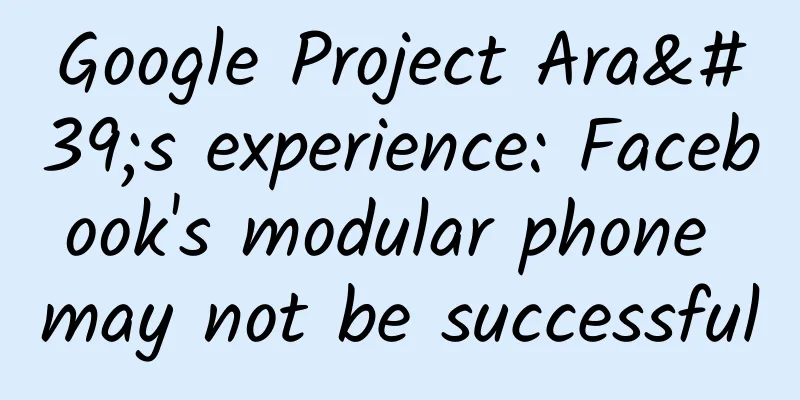Google Project Ara's experience: Facebook's modular phone may not be successful

|
When it comes to modular phones, I believe the first thing that comes to mind is Google's Project Ara, which was very popular in the industry before but ended in failure. And given that the main responsible team of Facebook's modular smartphone project, such as the person in charge Regina Dugan, was previously responsible for Project Ara at Google, we believe that its modular concept must be inextricably linked to Project Ara, and even the basic concepts are similar. Therefore, tracing back the reasons for the birth and ultimate failure of Project Ara is crucial to judging the prospects of Facebook's modular phones or modular phones with similar Project Ara concepts. Here we might as well take a look at where Google's Project Ara came from. According to foreign media reports after an in-depth interview with Google's Project Ara, the idea and foundation of Project Ara came from the patent of Modu, an Israeli innovative company acquired by it, plus a video of a modular phone on YouTube by Dave Hakkens, the founder of the Phonebloks website. Although the establishment of Project Ara may be far from simple, at least from the actual progress of Project Ara and the concept it has declared to the outside world, the above background is absolutely not to be ignored. Unfortunately, the Modu mobile phone, which tried modularization in 2008, ended in failure, and Phonebloks gradually became deserted after its initial popularity. The reason is that some industry analysts believe that the high degree of integration in the mobile phone industry has greatly reduced the cost of related components, while also increasing the threshold for modular assembly of mobile phones. It should be reminded that these only happened in 2008, nine years ago. Today, with the continuous enhancement of the functions of the mobile phone industry, the degree of integration of its components is higher (relatively raising the difficulty of modular assembly), and the cost is also lower (reducing the cost advantage of modular mobile phones). As we all know, for complete machine manufacturers, due to the fierce competition in the current smartphone market, most manufacturers ultimately compete on cost, and according to their own product planning (supported by a certain amount of shipments), they can naturally get the most favorable prices from accessory manufacturers, which is then reflected in the price competition in the market and their own profitability. In contrast, the modular mobile phone model without a certain quantity guarantee (the demand for each component will vary greatly) is not conducive to manufacturers participating in competition or is not suitable for the current competition mode of the smartphone industry. If the above is from the perspective of the manufacturer side of the industry chain, Project Ara is difficult to gain support. From the user side, although some users can find accessory modules that suit their needs, Google has determined the skeleton of the appearance design of the Project Ara smartphone (according to the Google Ara project team, the Project Ara phone has three sizes, large, medium and small, namely 4 inches, 5 inches and larger than 5 inches, and the "skeleton" is quite thick), which makes it very unlikely that the smartphone will be ultra-thin. This is undoubtedly contrary to the demands of current smartphone manufacturers and users, making smartphones as consumer electronics products, and users' choices in appearance (the so-called appearance) are greatly reduced, resulting in the homogenization of the appearance of Project Ara modular phones. It should be noted that the appearance of smartphones also plays a very important role in the user's choice decision, especially in today's increasingly homogenized smartphone hardware. The appearance design may be one of the main driving forces for users to purchase the phone, and this once again exposes the deviation of Project Ara modular phones from the market and user needs. In addition, due to modularization, the user's smartphone usage cycle will naturally be extended, but as a fashionable consumer product, users do not want to use their smartphones for too long. At least from the current point of view, the user's replacement cycle should be between 12 and 18 months, which is why Apple basically updates its iPhone in about a year. It should be added that Project Ara's modular update to extend the user's smartphone usage cycle may not be welcomed by relevant manufacturers. After all, from the perspective of different module manufacturers, the sooner the user updates their mobile phone modules, the better, because the profit of new products is higher than that of old products. Another point that is ignored is that customization will lead to differences in user needs for each module and each generation of products, which may lead to adaptation and compatibility problems between different generations of modules. Once these problems occur, how to determine which supplier's product is the problem and responsibility? Who should users go to? I wonder what the industry thinks of the above analysis of partners in the mobile phone industry chain, the competitive characteristics of the mobile phone market and user needs? We believe that the above dilemma faced by Project Ara still exists and is getting worse. If the above is the external objective environment that determines that modular mobile phones always have little prospect and are almost slim, then from the subjective point of view of Facebook itself, compared with the original Project Ara, it also lacks a clear purpose. That is, if Google previously pushed Project Ara to accelerate the popularization of smartphones with flexibility and low prices, and ultimately to expand the influence and users of its own Android ecosystem (not just modular mobile phones themselves), then what is the purpose of Facebook's push for modular mobile phones? In this way, Facebook's move is not even as good as the smartphone called HTC First launched in cooperation with HTC (the main function at that time was the Facebook Home launcher developed by Facebook, which could integrate the entire mobile phone interface with Facebook. When the screen is locked, users can view Facebook messages, etc.), and its purpose is to increase the stickiness of Facebook users (Facebook was still in a stage of urgent need to increase and retain users at that time). Although it ended in failure later, at least the purpose is clear. A clear purpose means that you will pay attention and continue to invest, and vice versa. Another point that cannot be ignored is that, as mentioned at the beginning of this article, the team responsible for this project mainly came from Google's previous Project Ara, and when the former host of the project, Regina Dugan, left Google and jumped to Facebook, she said in her blog that "the road to creating new products is always full of difficulties. Even if you are determined to move forward, you will inevitably face the hardships of cutting swords and halberds along the way. Not only do you need to face technical difficulties, but the challenges of management and thinking should not be underestimated. After several encounters, it is enough to make a small-scale entrepreneurial team discouraged." It can be seen that the conflict between her and Google at that time must have been considerable. Here, don't underestimate the impact of this conflict on the follow-up. Carmack, one of the founders of Oculus Rift acquired by Facebook, was previously sued by his old employer ZeniMax for Facebook's Oculus VR infringing on the company's patents. That is, due to copyright infringement, illegal use of trademarks and breach of confidentiality agreement (NDA), Oculus VR and its senior executives were sentenced to pay ZeniMax up to $500 million in compensation. Of course, Facebook paid the bill in the end. It should be noted that Carmack was only the technical director of ZeniMax at that time. In contrast, Regina Dugan, who is now at Facebook, was the head of the entire Google Project Ara project at that time. It is hard to imagine that the Facebook modular phone that Regina Dugan and her team, which is currently mainly from the Google Project Ara project, are responsible for can be completely separated from Project Ara. In other words, if Facebook's modular phone is really launched, it will face a great risk of litigation from Google in the future. Under the objective conditions that modular phones face challenges and have no prospects, if Facebook repeats the mistakes of the patent lawsuit between Oculus VR and ZeniMax, it will really be a loss for Facebook. In summary, we believe that given the failure of Google Project Ara before, the objective market demand and competitive environment faced by modular phones are increasingly unfavorable to their development, and the team of Facebook's modular phones mainly comes from Project Ara, while it indicates that its modular phone concept is difficult to break through and innovate, the negative impact it may face is instead apparent. After all, for Facebook, the lesson from the past is there. As a winner of Toutiao's Qingyun Plan and Baijiahao's Bai+ Plan, the 2019 Baidu Digital Author of the Year, the Baijiahao's Most Popular Author in the Technology Field, the 2019 Sogou Technology and Culture Author, and the 2021 Baijiahao Quarterly Influential Creator, he has won many awards, including the 2013 Sohu Best Industry Media Person, the 2015 China New Media Entrepreneurship Competition Beijing Third Place, the 2015 Guangmang Experience Award, the 2015 China New Media Entrepreneurship Competition Finals Third Place, and the 2018 Baidu Dynamic Annual Powerful Celebrity. |
>>: Xu Jiayin and Jia Yueting "suffocated together"? Today's FF is more like "reheated meat"
Recommend
2019Q1 Financial App Advertising Behavior Insight Report
Financial apps are the type of apps that account ...
Mobei Class 6th Foreign Trade SEO Optimization Promotion Google SEO (Google SEO)
Mobei Class 6th Foreign Trade SEO Optimization Pr...
WeChat cancels the two-minute deletion function! The crash scene that 99% of people have experienced is finally saved
I wanted to withdraw it, but accidentally pressed...
Why are there no mosquitoes whose bites don’t itch?
Speaking of the most annoying animals, they are f...
Chinese characteristics in the eyes of Japanese mobile game industry insiders: unique application distribution and promotion methods
via:appying If overseas games are to be released ...
Is it best not to come into contact with patients who have undergone chemotherapy? Can chemotherapy drugs be transmitted to people around you?
Rumor: "It is best not to contact patients w...
Taobao Operations: How did a trader review the sales volume from 0 to 5,000?
Many sellers are at a loss as to what to do when ...
APP overseas promotion, detailed explanation of ASO skills!
For apps that are promoted overseas, the current ...
How to prevent car fires in the hot summer?
Summer is the peak season for spontaneous combust...
Can the "invisibility technique" in movies and TV shows really be achieved? Scientists say: Yes!
Invisibility has always been a frequently appeari...
App promotion: preparation before listing on app stores and other promotion channels!
After the App is developed, promoting the App nat...
Why is Acer's presence in China declining? Three major flaws have caused it to fall behind
In recent years, there has been a "strange p...
Kuaishou announces full-link support for HDR video, enabling HDR video creation and consumption
Recently, Kuaishou APP announced that it will pro...
IEA: Accelerating a fair transition in the coal industry
The International Energy Agency published “Accele...
Segment "user activity status" to help you achieve KPI indicators
“Why has the conversion rate decreased? I can’t f...









